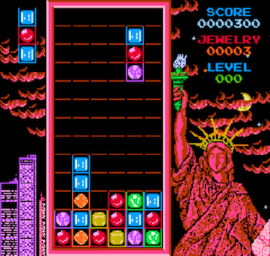Magic Jewelry
Magic Jewelry (Chinese: 魔法寶石; pinyin: Mófǎ Bǎoshí; lit.: 'Magic Gems'), is an unlicensed Nintendo NES tile-matching puzzle video game derivative to Columns, programmed in Taiwan by Hwang Shinwei and published by RCM in 1990.[1]
| Magic Jewelry | |
|---|---|
 Game screenshot on the FCEUX emulator. | |
| Developer(s) | Hwang Shinwei |
| Publisher(s) | RCM Group |
| Platform(s) | NES |
| Release | November 21, 1990 |
| Genre(s) | Puzzle |
| Mode(s) | Single-player |
Like many unlicensed games, it is most commonly found on pirate Famicom multicarts and systems. Various unofficial remakes have been released for iOS and Android.[2][3][4]
Overview
Gameplay
Magic Jewelry's gameplay resembles that of Columns and Dr. Mario, both of which released earlier in the same year. Sets of 3 or more matching coloured jewels must be lined up horizontally, vertically or diagonally in order to score points, while simultaneously removing said jewels. The jewels drop down in blocks of 3, and their positions in the blocks can be shifted freely until the block lands. After a certain number of jewels are cleared, a flashing "X" block drops, which upon landing on a jewel clears out all other jewels of the same colour, and the game advances to the next level, with the default drop speed of the blocks increasing. The game ends when a block is stacked with at least one jewel being over the top edge of the board.
Background
The background loosely resembles New York City, with a Statue of Liberty depicted on the right. In addition, there are clouds and stars in the background, along with a crescent moon which moves up the screen.
Music
The tracks played in Magic Jewelry are 8-bit versions of some copyrighted songs, along with pitch shifted versions of some of the tracks in Levels 8-15; Shinwei also used the same themes on some of his other Famicom unlicensed games . The tracks appear as such:
| Lvl | Alt lvl(s) | Song | Original artist |
|---|---|---|---|
| 0 | 8, 12 | "All Kinds of Everything" | Dana |
| 1 | 9, 11, 13 | "Happy Chinese Festival" (or "China Festival") | Chen Yang |
| 2 | 10, 14 | "Descendants of the Dragon" | Lee Chien-Fu (written by Hou Dejian) |
| 3[lower-alpha 1] | 15 | "Rise from Your Grave" | Tohru Nakabayashi |
| 4 | — | "Jägerchor (Hunters' Chorus)" | Carl Maria von Weber |
| 5 | "Moonlight on the Colorado" | Dick Robertson | |
| 6 | "Greensleeves" | — | |
| 7 | "Speak Softly Love" | Andy Williams |
Sequel
| Magic Jewelry II | |
|---|---|
| Developer(s) | Hwang Shinwei |
| Publisher(s) | RCM Group |
| Platform(s) | NES |
| Release | September 16, 1991 |
| Genre(s) | Puzzle |
| Mode(s) | Single-player, multiplayer |
In 1991 has been released Magic Jewelry II (Chinese: 寶石方塊二代; pinyin: Bǎoshí Fāngkuài Èr Dài; lit.: 'Gemstone Second Generation'),[5] that unlike the previous title was less known, due to its first appearance in a "150-in-1" multi-game cartridge. Several features were added:
- The intro cloned from original Columns, followed by a game instruction screen in poorly-written English.
- A main options menu almost partially taken from Hatris, allowing the player to choose a stage, change the column type (seven are in all; though the score bar would still be defined Jewelry), turning off apart points for certain pieces and music, and hiding the timer.
- Six new both background designs and column types, which for each are Nature (Fruit), (Card), (Hat), (Dice), Moscow Red Square (Block), and (Mahjong). Note that two of them, Hat and Dice, have that own one superimposed with the main night background.
- Two-player mode with an optional time limit called "Flash", possibly a mistranslation of "lightning" round.
- A female voice that incomprehensibly announces "Are You Ready?", when the game begins.
Also in this sequel were used the same eight copyrighted 8-bit third party songs, including pitched alterations, though "Moonlight on the Colorado" became the theme of Level 8; a new exclusive track took its place for Level 5 theme and is "Tennessee Waltz", by Cowboy Copas (although Hwang first introduced it in Block Force, and then in Punch Sprite). Additionally the initial song varies depending on the column type.
See also
Notes
- In Level 3 there's only one non-existent song, because it's taken from an arcade game, namely, Sega's Altered Beast Round 1 and 4.